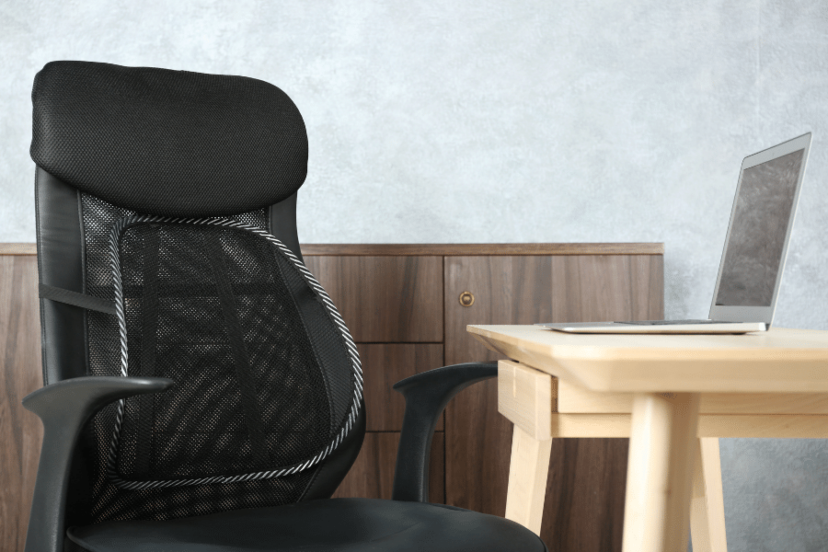Lumbar Support Products: Ergonomic aids to improve spinal alignment.
Introduction
As a researcher and advisor around the topic of back pain & its management, here I focus on ergonomic aids.
I understand the significance of maintaining proper spinal alignment for a healthy back. In today’s modern lifestyle, where we spend a considerable amount of time sitting or engaging in activities that strain our lower backs, lumbar support products have emerged as valuable tools to alleviate discomfort and promote good posture. In this article, we will explore the various types of lumbar support products available, their benefits, and provide helpful suggestions for selecting the right product to support your spinal health.
Importance of Lumbar Support Products
The lumbar region of the spine, located in the lower back, is particularly vulnerable to strain and injury due to poor posture, prolonged sitting, and repetitive movements. Lumbar support products, designed to provide targeted support to the lower back, play a vital role in maintaining proper spinal alignment. By reducing the strain on the lumbar region, these products help alleviate pain, improve posture, and enhance overall comfort.
Types of Lumbar Support Products
When it comes to lumbar support, there are several effective options available on the market. Understanding the different types will help you make an informed decision based on your specific needs.
Lumbar Pillows
Lumbar pillows are portable and versatile solutions for maintaining proper spinal alignment. They are designed to fit snugly against the natural curve of the lower back, providing support and relieving pressure. These pillows come in various shapes, sizes, and materials, allowing you to find the perfect fit for your individual comfort preferences.
Lumbar Rolls
Similar to lumbar pillows, lumbar rolls are cylindrical cushions that provide targeted support to the lower back. They are particularly useful in situations where the existing chair or seat does not offer adequate lumbar support. Lumbar rolls can be easily attached to chairs or car seats, promoting correct posture and reducing strain on the lower back.
Lumbar Support Belts
Lumbar support belts are wearable accessories designed to stabilize the lower back and provide compression. These belts are commonly used during heavy lifting or physical activities that involve repetitive movements. They offer additional support to the lumbar region, reducing the risk of injury and promoting proper spinal alignment.
Benefits of Using Lumbar Support Products
Using lumbar support products on a regular basis brings several advantages, ensuring the well-being of your back and overall posture.
Proper Spinal Alignment
One of the primary benefits of lumbar support products is their ability to maintain proper spinal alignment. By supporting the natural curvature of the lower back, these products help distribute the weight evenly and reduce the strain on the lumbar region. This promotes a neutral spine position, preventing discomfort and potential long-term spinal issues.
Pain Relief
Lumbar support products are often recommended to individuals experiencing lower back pain. The targeted support they provide helps alleviate pain by reducing pressure on the spine and surrounding muscles. Regular use of lumbar support products can contribute to pain relief and improved mobility.
Improved Posture
Maintaining good posture is essential for spinal health. Lumbar support products help align the spine, discouraging slouching and promoting an upright posture. By training the muscles and supporting the natural curvature of the lower back, these products encourage proper alignment, reducing the risk of postural issues.
Increased Comfort
Sitting for extended periods can lead to discomfort and fatigue. Lumbar support products offer added comfort by reducing strain on the lower back. They provide cushioning and support to ensure a more pleasant and ergonomic sitting experience, whether at home, in the office, or during travel.
Choosing the Right Lumbar Support Product
Selecting the appropriate lumbar support product can significantly impact its effectiveness and your overall comfort. Consider the following factors when choosing a product:
Assessing Your Needs
Before purchasing a lumbar support product, evaluate your specific needs. Assess the activities during which you experience discomfort or strain on your lower back. Determine if you require support while sitting, driving, or engaging in physical activities. Understanding your needs will help you identify the most suitable lumbar support product.
Considering Product Features
Different lumbar support products come with various features. Look for adjustable straps, breathable materials, and customizable support options. These features ensure optimal comfort and allow you to personalize the level of support needed for your back. Consider your preferences and any specific requirements when evaluating the features of lumbar support products.
Trying Different Options
Every individual is unique, and lumbar support preferences may vary. If possible, try out different lumbar support products before making a final decision. Experiment with lumbar pillows, rolls, and belts to find the one that offers the most comfort and optimal support for your lower back.
Incorporating Lumbar Support in Daily Life
To reap the maximum benefits of lumbar support, it is crucial to incorporate it into your daily routine. Here are some practical suggestions for utilizing lumbar support aids effectively:
At the Office
If you spend long hours working at a desk, consider using a lumbar pillow or roll to support your lower back. Adjust your chair’s height and position to maintain proper posture, and take regular breaks to stretch and move around. Utilize ergonomic office equipment and ensure your workspace is set up in a way that promotes good spinal alignment.
While Driving
Maintaining proper spinal alignment while driving is essential for long trips or daily commutes. Use lumbar support products such as rolls or pillows to support your lower back. Adjust the seat position to maintain an upright posture and take breaks to stretch during extended drives.
During Exercise
When engaging in physical activities, protect your lower back with a lumbar support belt. It provides stability and reduces the risk of injuries during exercises that involve bending, lifting, or repetitive motions. Remember to warm up before exercising and consult with a healthcare professional for exercise routines that suit your specific needs.
Conclusion
Incorporating lumbar support products into your daily life can greatly contribute to maintaining proper spinal alignment and promoting a healthy back. Whether you choose lumbar pillows, rolls, or belts, these aids offer numerous benefits, including improved posture, pain relief, and increased comfort. Remember to assess your needs, consider product features, and try different options to find the lumbar support product that works best for you. By prioritizing your spinal health, you can enjoy a pain-free and comfortable lifestyle.
For further information & helpful advice click here.
FAQs
1. How long should I use a lumbar support product?
The duration of lumbar support product use depends on individual needs and preferences. Some individuals may benefit from using lumbar support products continuously, while others may find relief with periodic use during activities that strain the lower back. Listen to your body and adjust the usage accordingly.
2. Can lumbar support products prevent back injuries?
Lumbar support products can provide additional support and stability, reducing the risk of back injuries. However, they should not replace proper lifting techniques, exercise, and maintaining a healthy lifestyle. It is important to use lumbar support products as a complementary measure to promote spinal alignment and reduce strain.
3. Are lumbar support belts suitable for everyone?
Lumbar support belts are generally safe and beneficial for individuals who require additional support during physical activities or heavy lifting. However, it is advisable to consult with a healthcare professional, particularly if you have pre-existing medical conditions or chronic back problems, to determine if a lumbar support belt is suitable for you.
4. How often should I replace my lumbar pillow?
The lifespan of a lumbar pillow depends on its quality, materials used, and frequency of use. Generally, it is recommended to replace lumbar pillows every 1-2 years or when they start losing their shape and support. Regularly inspect your lumbar pillow for signs of wear and tear and replace it if necessary.
5. Can I use lumbar support products during pregnancy?
During pregnancy, it is essential to consult with a healthcare professional before using any lumbar support products. They can provide guidance based on your specific needs and recommend suitable products or alternative methods to support your lower back and maintain proper spinal alignment during pregnancy.







